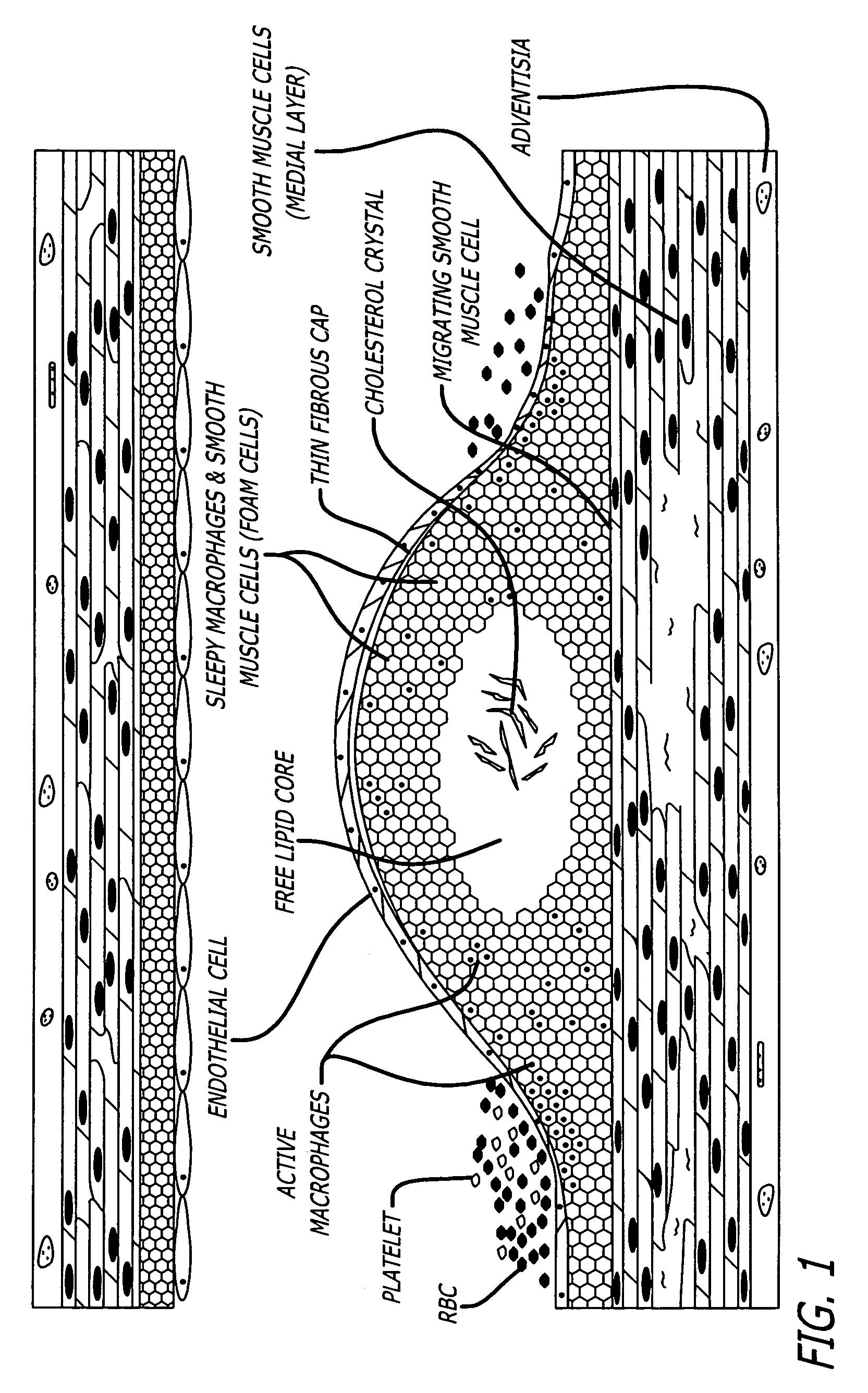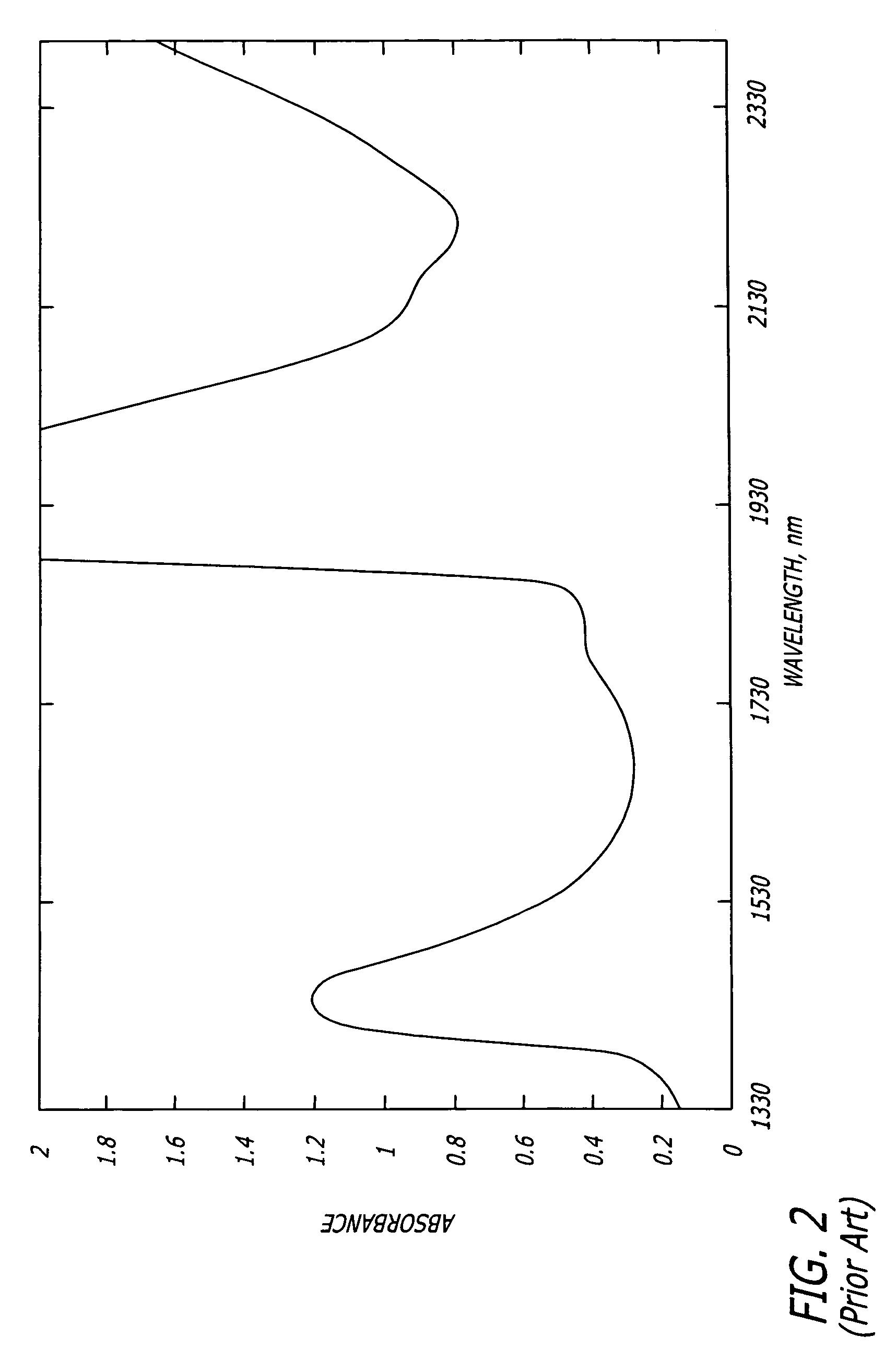[0031]The methods and devices of the present invention provide an improvement over known methods and devices for distinguishing vulnerable plaque in a living vessel. As used herein, the term “at-risk”, “vulnerable,”“dangerous” or “unstable” plaque means an atherosclerotic plaque which, in a living vessel, is likely to develop a
fissure, rupture or develop a
thrombus leading to a life-threatening event. While most prior art methods are aimed at detecting and treating lumen
stenosis, the present invention provides detection of an earlier stage of
disease that precedes hemodynamically significant narrowing of the
artery. This is an important
advantage, especially since research over the past decade has established that these lesions account for most fatal myocardial infarctions (heart attacks) and many strokes. The methods and apparatus of the present invention provide for the first time a clinically useful tool to determine which
lesion is dangerous and needs pre-emptive treatment.
[0035]In accordance with the present invention, a method of detecting a vulnerable atherosclerotic plaque on a vessel wall is provided. The method includes simultaneously measuring in
a site on a living vessel wall two or more chemical parameters associated with actively metabolizing cells (such as macrophages and other inflammatory cells, and
smooth muscle cells). It is these highly active cells which are present in inflamed vulnerable atherosclerotic plaque. The qualitative or quantitative measurement of at least two of the following parameters is performed: pH, nitrosyl
hemoglobin, nitrosyl
tyrosine, glucose, lactate, oxidized collagen, oxyhemoglobin,
reduced hemoglobin, oxidized
cytochrome oxidase aa3. A preferred embodiment measures pH and oxidized collagen and, optionally, at least one other parameter from the following group: nitrosyl
hemoglobin, nitrosyl
tyrosine, glucose, lactate, oxyhemoglobin, deoxyhemoglobin and oxidized
cytochrome oxidase aa3. In certain embodiments, the method also includes detecting leakage of dye into a plaque whereby a plaque cap
fissure is revealed. The detection is accomplished by simultaneously measuring in a living vessel at least two chemical parameters, factors, or analytes, associated with inflamed vulnerable atherosclerotic plaque. This includes providing a
fiber optic catheter having an illumination
fiber bundle and a detection
fiber bundle capable of, respectively, directing light onto or receiving light from
a site on a vessel wall, the catheter having means for reducing optical interference by blood or other fluid within a vessel when undergoing examination. It also includes providing a source of 400-2500 nm
wavelength light and a
spectrometer, each operatively linked to the corresponding
fiber bundle.
[0043]A method of treating a patient known to be suffering from atherosclerotic
vascular disease and suspected of being at risk of experiencing a
plaque rupture and / or an occlusive thrombotic event, is also provided by the present invention. The method comprises detecting an atherosclerotic plaque at risk of rupturing or thrombosing by taking chemical parameter measurements and dye sequestration measurements, as described above, and, optionally but preferably including monitoring the visible
color image of the site and analyzing the visual image together with the chemical parameter and dye measurements, to obtain a predictive level of risk. Knowing the predicted level of risk for at least one site or group of sites on a wall of said vessel, at least one vulnerable plaque is then targeted for treatment. A localized therapeutic intervention or treatment is then administered to at least one of the targeted plaques. Suitable treatments can then be administered, for example,
balloon angioplasty,
laser angioplasty, heated
balloon (RF,
ultrasound or
laser)
angioplasty, surgical
atherectomy, laser
atherectomy, the placement of an appropriate
stent, another conventional mechanical or
irradiation treatment method, and
pharmacological treatment regimens including anti-coagulants, fibrinolytic, thrombolytic, anti-inflammatory, anti-proliferative, immunosuppressant, collagen-inhibiting,
endothelial cell growth-promoting, and conventional pharmacologically appropriate local treatments effective for reducing or eliminating inflamed plaque.
[0050]The methods and apparatus of the present invention go beyond the existing methods and devices for identifying
a site of infection,
cancer, a wound or the presence of
autoimmune disease, and is particularly advantageous for identifying dangerous, rupture-prone plaque. Testing a vessel wall for combinations of specific chemical analytes associated with vulnerable plaque provides a better approach to distinguishing the particularly at-risk plaques from relatively stable atherosclerotic plaques in a living vessel.
 Login to View More
Login to View More  Login to View More
Login to View More 


